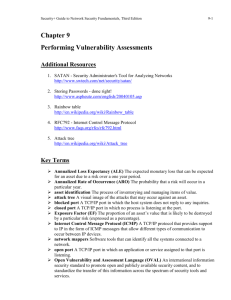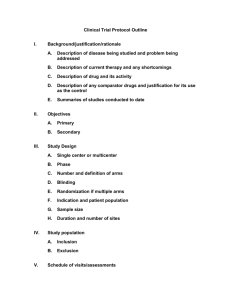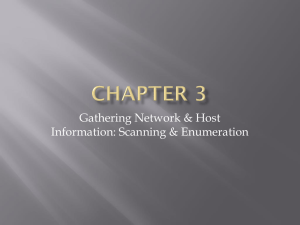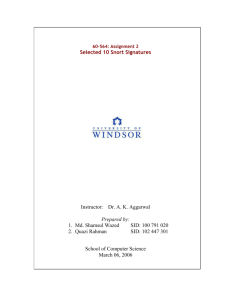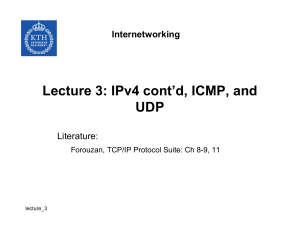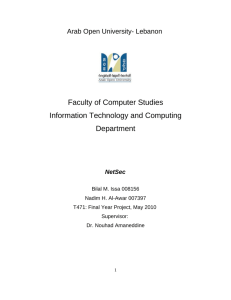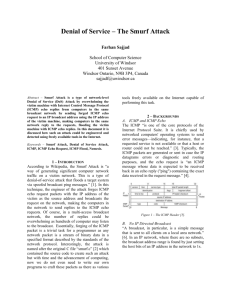Adams.Nick Test 4 Part 2
advertisement
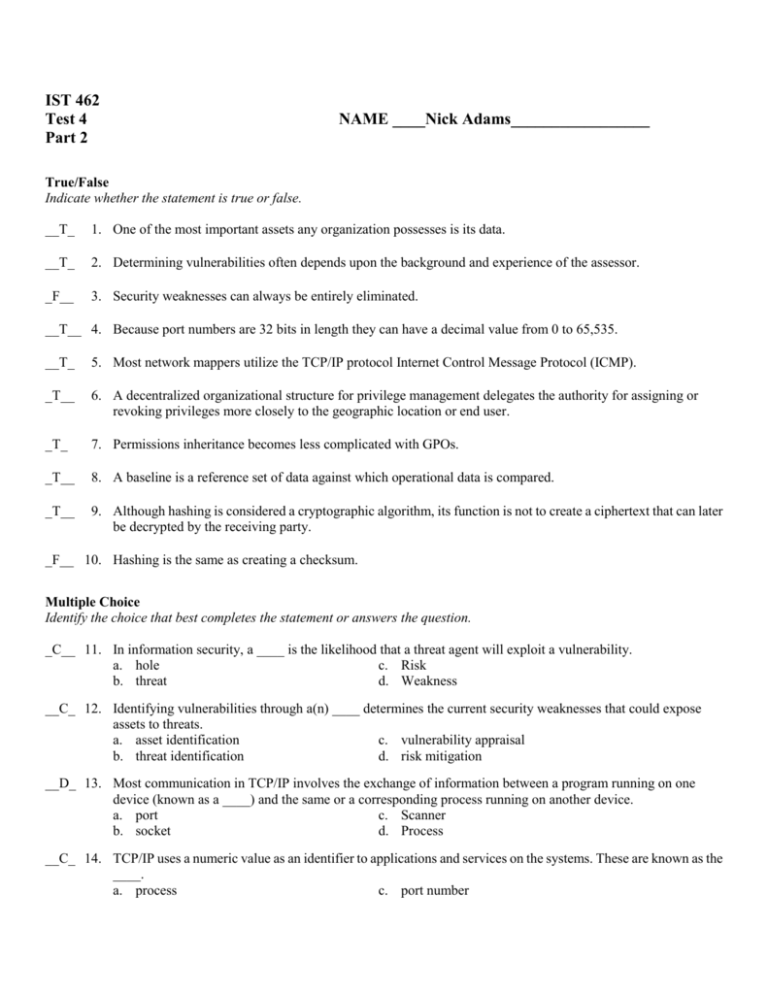
IST 462 Test 4 Part 2 NAME ____Nick Adams_________________ True/False Indicate whether the statement is true or false. __T_ 1. One of the most important assets any organization possesses is its data. __T_ 2. Determining vulnerabilities often depends upon the background and experience of the assessor. _F__ 3. Security weaknesses can always be entirely eliminated. __T__ 4. Because port numbers are 32 bits in length they can have a decimal value from 0 to 65,535. __T_ 5. Most network mappers utilize the TCP/IP protocol Internet Control Message Protocol (ICMP). _T__ 6. A decentralized organizational structure for privilege management delegates the authority for assigning or revoking privileges more closely to the geographic location or end user. _T_ 7. Permissions inheritance becomes less complicated with GPOs. _T__ 8. A baseline is a reference set of data against which operational data is compared. _T__ 9. Although hashing is considered a cryptographic algorithm, its function is not to create a ciphertext that can later be decrypted by the receiving party. _F__ 10. Hashing is the same as creating a checksum. Multiple Choice Identify the choice that best completes the statement or answers the question. _C__ 11. In information security, a ____ is the likelihood that a threat agent will exploit a vulnerability. a. hole c. Risk b. threat d. Weakness __C_ 12. Identifying vulnerabilities through a(n) ____ determines the current security weaknesses that could expose assets to threats. a. asset identification c. vulnerability appraisal b. threat identification d. risk mitigation __D_ 13. Most communication in TCP/IP involves the exchange of information between a program running on one device (known as a ____) and the same or a corresponding process running on another device. a. port c. Scanner b. socket d. Process __C_ 14. TCP/IP uses a numeric value as an identifier to applications and services on the systems. These are known as the ____. a. process c. port number b. socket d. Protocol __B_ 15. ____ are typically used to determine the state of a port to know what applications are running and could be exploited. a. Network scanners c. Port testers b. Port scanners d. Network testers __B_ 16. ____ are software tools that can identify all the systems connected to a network. a. Port scanners c. ICMP mappers b. Network mappers d. ICMP scanners __A_ 17. ____ provides support to IP in the form of ICMP messages that allow different types of communication to occur between IP devices. a. SNMP c. HTTP b. SMTP d. ICMP __D_ 18. ____ is a generic term that refers to a range of products that look for vulnerabilities in networks or systems. a. Port scanner c. Ping b. Network mapper d. Vulnerability scanner __D_ 19. ____ is a method of evaluating the security of a computer system or network by simulating a malicious attack instead of just scanning for vulnerabilities. a. Vulnerability scanning c. Port scanning b. Network mapping d. Penetration testing __C_ 20. The ____ is typically defined as the person responsible for the information, who determines the level of security needed for the data, and delegates security duties as required. a. guardian c. Owner b. manager d. Custodian __D_ 21. The Windows file and folder ____ permission allows files or folders to be opened as read-only and to be copied. a. Write c. Modify b. Read and Execute d. Read __D_ 22. ____ assigns a level of business importance, availability, sensitivity, security and regulation requirements to data. a. Usage auditing c. Usage classification b. Security auditing d. Data classification _C_ 23. ____ is the process for generating, transmitting, storing, analyzing, and disposing of computer security log data. a. Log management c. Event management b. Log auditing d. Event auditing __C_ 24. ____ servers are intermediate hosts through which Web sites are accessed. a. NIDS c. Proxy b. Authentication d. HIPS __B_ 25. Logs based on ____ are the second common type of security-related operating system logs. a. event records c. event logs b. system events d. audit records __C_ 26. ____ refers to a methodology for making changes and keeping track of those changes, often manually. a. Event auditing b. Event management c. Change management d. Log management __A_ 27. ____ monitoring compares activities against a predefined signature. a. Signature-based c. Behavior-based b. Anomaly-based d. Time-based __B_ 28. A ____ baseline is a reference set of data established to create the “norm” of performance for a system or systems. a. configuration c. System b. performance d. monitoring __A_ 29. Data that is in an unencrypted form is called ____ data. a. plaintext c. hidetext b. caesartext d. cleartext __A_ 30. ____, also called a one-way hash, is a process for creating a unique “signature” for a set of data. a. Digital signing c. Hashing b. Decrypting d. Encrypting __B_ 31. The simplest type of stream cipher is a ____ cipher. It simply substitutes one letter or character for another. a. transposition c. permutation b. substitution d. homoalphabetic __A_ 32. A ____ substitution cipher maps a single plaintext character to multiple ciphertext characters. a. polyalphabetic c. homoalphabetic b. monoalphabetic d. random __B_ 33. ____ was approved by the NIST in late 2000 as a replacement for DES. a. AES c. Twofish b. 3DES d. Blowfish __C_ 34. ____ is a block cipher that processes blocks of 64 bits. a. SHA-1 c. RC2 b. RC4 d. MD5 __D_ 35. The asymmetric algorithm ____ was published in 1977 and patented by MIT in 1983. a. AES c. SHA b. Diffie-Hellman d. RSA __C_ 36. The strength of the ____ algorithm is that it allows two users to share a secret key securely over a public network. a. DES c. Diffie-Hellman b. RSA d. AES __D_ 37. Microsoft’s ____ is a cryptography system for Windows operating systems that use the Windows NTFS file system. a. GPG c. PGP b. AES d. EFS __B_ 38. Cryptography can also be applied to entire disks. This is known as ____ encryption. a. symmetric c. file system b. whole disk d. EFS __C_ 39. To protect data stored on a hard drive, Microsoft Windows Vista includes ____ drive encryption. a. IDEA c. BitLocker b. TPM d. AES __A_ 40. ____ is a hardware-enabled data encryption feature. a. BitLocker c. AES b. EFS d. DES
